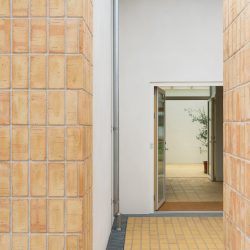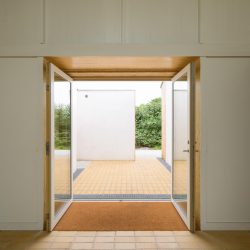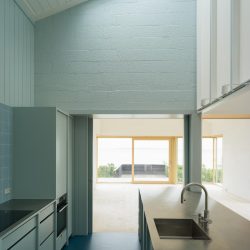
Johansen Skovsted Arkitekter , Johannes Schotanus . photos: © Hampus Berndtson
The house is designed for a couple whose lifestyle is closely connected with nature and the sea. They desired a home that reflects and complements this way of life. The long and staggered building volume envelops a non-hierarchical layout of diagonally connected rooms. These connections create views of the landscape and the sea from all principal rooms and a non-hierarchical interweaving of inside and outside spaces. The mason exterior walls protect against the elements, whilst the wood interior walls create an informal atmosphere. The wooden surfaces are left unpainted in the passages between rooms to make a clear spatial de-lineation.
The house is located by the Øresund, the strait between Denmark and Sweden, in a diverse residential neighbourhood consisting of older villas, newer homes and fisherman’s cottages. The area is characterised by its varied architecture, where one of the few common denominators are yellow brick walls and yellow or white plastered walls.
The building’s long pitched roof mirrors the pitched roof of the building across the public beach park. The two buildings frame the public beach park with their perpendicular placement to the coast and the road. The house intends to leave a discrete impression towards its surroundings with its low-slung façades that are narrowed at the gabled ends of the house. The yellow brick facings create a visual relation to the buildings in the area. The corrugated zinc roof appears in the same colour as the often-changing skies, without being reflective.
Around the building, smaller auxiliary structures house a garden shed, a workshop, and a sauna. An entrance courtyard, a morning terrace with an outdoor kitchen, a covered evening terrace, and a framed herb garden are situated between these structures and the main building, sheltered from the sometimes harsh weather of Øresund. These outdoor spaces are integrated with the building’s interior spaces by executing these spaces with white plastered walls that mirror the white interior walls.
The framed herb garden by the road stands as a cultivated planted area. The rest of the landscape around the building is low-maintenance and ‘natural’, extending the native plants and grasses of the beach and windbreak.
Tensioned steel columns on the house’s exterior stabilise the load-bearing walls, making it possible to have very slim columns in the interior at the corner windows. The walls are constructed using insulated lightweight Expanded Clay blocks, clad with yellow brick facings glued vertically with visible mortar joints. The brick facings are glued in a tiled pattern that reveals their non-load bearing and thin properties. The usage of brick facings saved 75% of bricks compared to a conventional brick wall.
_




























